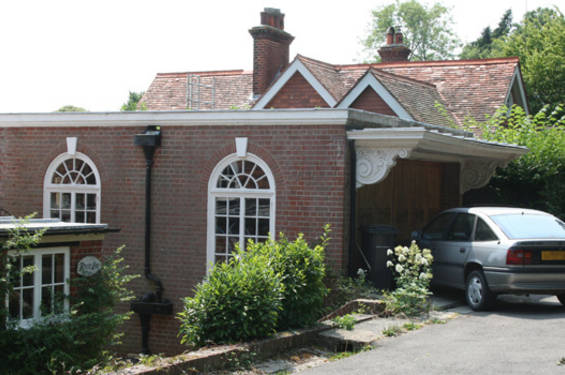This website uses cookies
This website uses cookies to enable it to function properly and to analyse how the website is used. Please click 'Close' to accept and continue using the website.



September 2009 - The Garage, Hilden, Rye Hill – a Rolls Royce of garages?
Horace Field, by Timothy Brittain-Catlin
Rye Hill is the name of the area around the steep road that leads into the picturesque East Sussex town of Rye from the north. To architectural historians it is probably best known for Reginald Blomfield’s large houses from the late 1890s, including his own country residence at Point Hill (a cottage that he expanded in every direction), and Saltcote Place, a Queen Anne-style mansion for the Hennessys, the French cognac distillers. A lane from the hill leads towards Green Hedges, another Blomfield house, passing on the way what was once the residence of the Tate family, a house called Hilden. Between these two you can see a garage building which, although very small, is an intriguing and poignant relic of a largely forgotten architectural career.
The garage was designed by Horace Field (1861-1948), a member of the Art Workers’ Guild who launched himself with a series of very fine houses and a bank in Hampstead, in different styles but which all tended towards the early seventeenth-century. He is mainly remembered now, if at all, for two prominent exercises in Edwardian baroque – a headquarters for the North Eastern Railway at York, and the Church Times offices near Aldwych in London. But his career continued well after the First World War, in particular as the architect of a number of delightful branches of Lloyds Bank. These include the palazzo-like premises in the centres of Aylesbury, Buckinghamshire, (1920-23) and Southampton (1925-30). This latter building, almost the sole survivor of what was once considered the most picturesque high street in the country, is particularly interesting because its overall composition suggests that of Lloyds head offices in Cornhill in the City of London by John James Burnet and W Campbell-Jones, which, curiously enough, seem to have been designed less than two months later.
And Field was indeed an architect who appears to have missed out on big opportunities later in his career. He never became Lloyds’ principal architect, and jobs that ought to have been his went to imitators: for example in 1915-16 he restored a row of old shops for the bank at 5-7 The Borough, Farnham (Surrey), creating an exquisite ‘Quality Street’-like sequence; but the job of building the big new branch nearby eventually went to T Millwood Wilson. Many of his works were designed for golf players, or near golf courses, including a splendid house called Gorse Hill (1928) on the outskirts of Aldeburgh (Suffolk); it’s possible that a retiring life appealed to him. At any rate, by the time Gorse Hill was completed he no longer regularly featured in popular books on house design.
From the mid-twenties onwards Field started to refine his style so that it consisted of a small number of repeated features set off against substantial brick walls. The overall form was ‘Queen Anne’ (real Queen Anne, that is, not Art Workers’ Guild Queen Anne); there were typically tripartite sliding sash windows; yeux de boeuf; and very prominent, and eventually extremely prominent, ornamental consoles. You can see these features on Lloyds branches such as those at Andover, Hampshire (his second project there, at 22 High Street, of 1920-22); Norbury, Surrey (1923-26); and the delightful little building at Hartley Wintney in Hampshire (1927-29).
Immediately after the War Field remodelled the local Lloyds in Rye, a coarse gothic building of 1895 by the bank’s usual architect J.A. Chatwin of Birmingham, to look like an early eighteenth-century tile-hung cottage. In 1925 he returned to design a house called Roundel Gate for the Findlaters, literary sisters with smart connections, and soon after its completion, in late 1929, he was called upon to design a garage nearby for James Tate of Hilden. At the beginning of that year Tate had acquired a Rolls Royce Phantom 1, a car which requires more than just a mere shed to put it in. It seems that the more Field sank into obscurity, the more he exaggerated his trademark features: at 68 he was increasingly desperate, perhaps, to ensure his name was remembered. He produced for Tate a building that has the most extraordinary consoles; a building which, if you come upon it unexpectedly, has an almost shocking effect. Vanburgh himself could not have done it better.
Timothy Brittain-Catlin is the author of The English Parsonage in the Early Nineteenth Century, and a monograph on Leonard Manasseh for The Twentieth Century Society’s series of books on 20th Century Architects. He is interested in the architecture of ‘Quality Street’, and would welcome any information about Horace Field. He teaches at the Kent School of Architecture, University of Kent, where he can be reached on tjb33@kent.ac.uk.
Look for past Buildings of the Month by entering the name of an individual building or architect or browsing the drop down list.

Become a C20 member today and help save our modern design heritage.